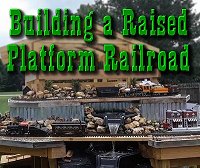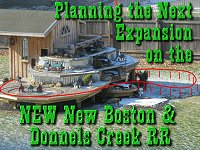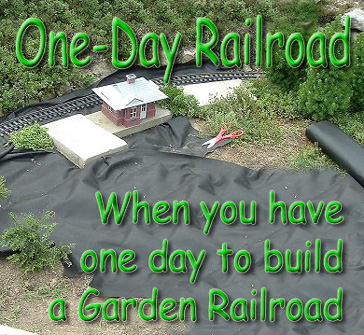 | |||
 |
 |  | |
 |  | ||
 |  | ||
 |  | ||
 |  | ||

| Please Read: How to Help Our Site at No Cost to You - Some of our articles contain recommendations for products we like and vendors we personally trust. Some of those vendors may pay us a very small commission if you click on a link and buy their products. This costs you nothing at all and helps offset the costs of what we do. So if we point you to something you decide to buy later, please make certain you come back through our site and click on the link directly. Thanks. |


|
February, 2020 Update from Family Garden TrainsTMNote: This is the web version of a newsletter from the Family Garden TrainsTM web site, which publishes information about running big model trains in your garden as a family activity.If you are not subscribed to the Family Garden Trains newsletter, and you would like to subscribe, please join our Mailing List, and specify that you want to receive e-mail updates. Also, if you would like to subscribe to our free newsletter for indoor railroads and seasonal display villages, please join the "Trains-N-TownsTM mailing list. You can subscribe to either, both, or neither, and we will just be glad to be of service, no matter what you decide. Fine Print: If you are receiving our e-mail updates and you no longer wish to subscribe, please e-mail me with a "Please Unsubscribe" message (worded any way you wish), and we will graciously remove you from our list.
Update for February, 2020Welcome to 2020. This newsletter was supposed to go out in January, so I left that first sentence in. But I kept coming up with more information I wanted to include, plus we've had so many new signups it took me days to get them all into the system. Some of our readers may be tired of me focusing so much on our current railroad project. Rest easy; most of the real work should be done in a few months, then we can get back to catching up on other topics. But in the meantime, I am trying very hard to make garden railroading more fun for more future hobbyists. Part of that includes recommending materials and approaches that will enable you to keep running trains whenever weather permits as long as you plan to live in your house. And that can only benefit the hobby, as visitors and family see you having more fun more often, and for years longer than most traditionally-installed garden railroads frankly permit. I DO plan to eventually get back to writing new articles about other topics (and updating old ones). On another subject, we're getting some interesting discussions on our Facebook page (https://www.facebook.com/Family-Garden-Trains-146646465358072/). If you want to keep up-to-date on little things, like who is closing out Bachmann Climaxes at a good price, or what products to avoid at your hardware store's "garden center," you might want to check that page out. Here's a caveat - though we technically have hundreds of followers, the way Facebook's algorithms work, only about twenty of our followers see our posts every day. A couple of our readers who haven't even "followed" the page check back every day just to make certain they're not missing anything interesting. Not saying you need to do that - we don't even post there every day. But you might want to check every so often. And don't feel bad about chiming in, as long as you're polite to your fellow hobbyists. Also, please feel free to use the contact page that we have links to on every page of our web site. Chances are if you have a question, there are twenty other readers with the same question. In fact, the first fifty or so articles I wrote for our site were inspired by reader questions. Well, if I don't sign off now, it will be March before you see this, so let me wish you a fun, safe, and productive garden railroading season. And please keep in touch. In This IssueThe following content is linked to or included in this newsletter:
Click on the link below to see an overview of what it takes to build a simple raised platform railroad in your back yard with tools you probably already own.
In a way this is a companion piece for the "Raised Railroad" article listed above. That article shows a very simplified version of the approach we have taken, and this paper shows how the same approach can be used to build a much more complex, low-maintenance, high-interest outdoor railroad. We're not done yet, but this should hopefully help you "put the pieces together" when it comes to figuring out what we've done and what we have left to do. Click on the link below to see a summary of what we've spent the last three summers building in our back yard.
Click on the link below to see the options we are reviewing for the next and last expansion.
Click on the following link to see our status as of late January, 2020.
Admittedly, the original "One Day Railroad" concept was overstated, since it required a great deal of preparation before you started actual construction. But the concept caught on, if the amount of copycat articles and outright plagiarism that appeared on other sites in the following months were any indication. In light of the errors in the early version of the article, I could have just taken it down and avoided further embarrassment, but I have no way of knowing how many of the copycat articles are still out there leading folks in the wrong directions. So I've updated my original article with my "lessons learned" and am making the new version available. I have a few other articles to update for similar reasons. Most of the "Git 'er done" approaches in the hobby have proven inadequate over the long term, often leading to disappointment. There's no sense burdening new folks with obsolete ideas and approaches. If you want to see the revised article, you can click on the following link. Garden Railroading in March - If you have seasons where you live, here's some things you can do in late winter/early spring to prepare for a great season.
NGRC at Nashville in 2020 - Another reminder: The National Garden Railway Convention will be in Nashville this year, May 31 through June 6. As of this writing, I'm signed up to deliver two clinics, and I plan to allot plenty of time for questions. So plan to drop by. Several folks who are experts in their fields are signed for others, including my friend Nancy Norris, horticulture editor for Garden Railways. There are some fantastic railroads in the area, too, so the tours alone will be worth the price of admission. To see the convention's home page, click on the following link. (Hint: most of the information you need is behind the "menu" icon.)
Keep in TouchFinally, please let us know about your ongoing projects. Ask questions, send corrections, suggest article ideas, send photos, whatever you think will help you or your fellow railroaders. In the meantime, enjoy your trains, and especially enjoy any time you have with your family in the coming weeks, Paul Race To view the newsletter for December, 2019, click on the following link: To read more, or to look at recommended Garden Railroading and Big Indoor Train products, please click on the index pages below.
|


|
Note: Family Garden TrainsTM, Garden Train StoreTM, Big Christmas TrainsTM, BIG Indoor TrainsTM, and BIG Train StoreTM are trademarks of
Breakthrough Communications (btcomm.com). All information, data, text, and illustrations on this web site are
Copyright (c) 1999, 2000, 2001, 2002, 2003, 2004, 2005, 2006, 2007, 2008, 2009, 2010, 2011, 2012, 2013, 2014, 2015, 2016, 2017, 2018, 2019, 2020 by
Paul D. Race. Reuse or republication without prior written permission is specifically
forbidden.
Family Garden Trains is a participant in the Amazon Services LLC Associates Program,
an affiliate advertising program designed to provide a means for sites to earn advertising
fees by advertising and linking to amazon.com.
For more information, please contact us
 |  |
| Visit related pages and affiliated sites: | |||||
| - Trains and Hobbies - | |||||
 |  |
 |
 |
 |  |
 |

|

|  |
 |

|
| - Christmas Memories and Collectibles - | |||||
 |

|
 |

|
 |

|
| - Family Activities and Crafts - | |||||
 |

|

|

|

|

|
| - Music - | |||||

|
 |
 |

|

|

|

|

|

|

|

|

|

|

|

|

|

|

|
 Building a Raised Platform Railroad
Building a Raised Platform Railroad Building the NEW New Boston and Donnels Creek (So Far)
Building the NEW New Boston and Donnels Creek (So Far) Expansion Planning, 2020
Expansion Planning, 2020 Train Storage Solutions, 2020
Train Storage Solutions, 2020 "One-Day Railroad" Revisited
"One-Day Railroad" Revisited